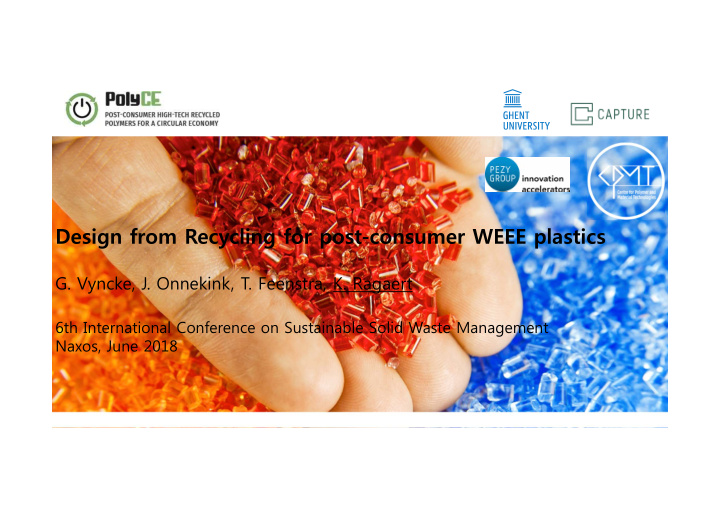



Design from Recycling for post-consumer WEEE plastics G. Vyncke, J. Onnekink, T. Feenstra, K. Ragaert 6th International Conference on Sustainable Solid Waste Management Naxos, June 2018
CPMT group & team recycling MATCH DEPARTMENT OF MATERIALS, TEXTILES AND CHEMICAL ENGINEERING
CPMT group & team recycling TEAM RECYCLING Our mission is to contribute to the circular economy by demonstrating the sustainable potential of plastics . MATCH This is achieved by transferring fundamental materials science to improved industrial processing of recycled plastics . DEPARTMENT OF MATERIALS, TEXTILES AND CHEMICAL ENGINEERING H 2 O CO 2 PLASTICS TO RESOURCE
Presentation outline • Framework: (WEEE) plastics in the EU • Design from Recycling • Tools for Design from Recycling • Outlook
Solid plastic waste in EU Source: Plastics The Facts 2017, PlasticsEurope 5
EU Strategy for Plastics in a circular economy • Released January 18 • Includes overview of planned EU measures to implement Strategy Goals: • 2025: recycle 55% of plastics packaging • 2030: all plastics packaging recyclable • 2030: over 50% of ALL plastics are recycled 6
Plastics in WEEE • Dominated by ABS, HIPS and PC • Challenges for effective recycling: • Flame retardants • Stable supply • A sufficient ‚feel‘ for the properties • Specific design guidelines
Presentation outline • Framework: (WEEE) plastics in the EU • Design from Recycling • Tools for Design from Recycling • Outlook
Design for Recycling ‘As a first step, and under the framework of the Ecodesign directive, the Commission has developed and will propose shortly to Member States mandatory product design and marking requirements to make it easier and safer to dismantle, reuse and recycle electronic displays’ ‘The Commission is also proposing to encourage better product design by differentiating the financial contribution paid by producers under extended producer responsibility schemes on the basis of the end-of-life costs of their products. This should create a direct economic incentive to design products that can be more easily recycled or reused .’ ‘The designed-for-recycling method incorporates recycling and recyclability criteria into the design phase of products, with the aim of obtaining recycled and/or recyclable products.’ Julio Rodrigo and Francesc Castells, Rovira i Virgili University Design for Recycling relates to: – design for disassembly – eco-design ( EU Ecodesign directive ) = designing a product to make it easier to recycle into the individual composing materials at its end-of life
Design for Recycling making it easier to recycle the individual materials making up the product at its end-of life DESIGN FOR RECYCLING Source: EU Parliament, 2015, Circular economy: the importance of re-using products and materials
Design from Recycling Developing new products, based on available recycled materials, at start-of life. DESIGN FROM RECYCLING Material-driven design approach 1. Knowing the possibilities and properties of the available r-polymers 2. Matchmaking between products and available r-polymers 3. ‘tweaking’ r-polymers if you have to (remain cost-effective) 4. Adapted product design for r-polymers • This includes mould design DESIGN FOR RECYCLING Making it easier to recycle the individual materials making up the product at its end-of life .
Design from Recycling Developing new products , based on available recycled materials, at start-of life . challenges Material-driven design approach • Engineer-speak vs designer-speak 1. Knowing the possibilities and properties of the • Recycling the recycled available r-polymers • Retained functionality of additives 2. Matchmaking between products and available • Industrial inertia r-polymers • Prices of virgin feedstock 3. ‘tweaking’ r-polymers if you have to (remain cost-effective) 4. Adapted product design for r-polymers • This includes mould design Design from Recycling requires a close symbiosis between designers and engineers
Design from Recycling DESIGN FROM RECYCLING DESIGN FOR RECYCLING DESIGN FROM RECYCLING DESIGN FOR RECYCLING
Presentation outline • Framework: (WEEE) plastics in the EU • Design from Recycling • Tools for Design from Recycling • Outlook
Design strategy – new product Good Good • A step-by-step process for the development Concept Concept of a good product choose material (group) choose material (group) • Consider the recycled material as ‘just another material’ with its given properties good geometry good geometry Good mould Good mould Good production Good production process process Good Good pr Good Good pr prod prod oduct oduct 15
Design strategy – recycled content drop-in • All steps have already been taken. Moulding tool is in place and must be used with minimum adjustment • Aim to bring recycled materials as much as possible to the same properties as the virgin material, both in terms of mechanical properties and processing. • --> blending, use of additives, adapted procesisng conditions Good Concept choose material (group) good geometry Good mould Good production process 16 Good ood pr product uct
Living hinge the dEEEterminator Square hole Snaps Ribs axial and radial Logo’s • A tactile tool for the hands-on PolyCE Shrink indicator evaluation of material properties Screw boss • Supplement to TDS • Allows to bring out aspects, specific to EEE products like gloss, snaps, living hinge, screw boss, surface thinning… Critical surface Stiffness test thinning 17 Stepwise Surface finish thicknesses
Presentation outline • Framework: (WEEE) plastics in the EU • Design from Recycling • Tools for Design from Recycling • Outlook
Outlook • Application of Design from Recycling strategy and tools to effective products in large-scale demonstrator project PolyCE • Expected to market from 2019 onwards
THANK YOU FOR YOUR ATTENTION Prof. Dr. Kim Ragaert Sustainable Use and Recycling of PolyCE Polymers Post.Consumer High-Tech Recycled Polymers for a Circular Economy kim.ragaert@ugent.be +32 9 331 03 91 www.polyce.eu Ghent University Faculty of Engineering and Architecture MATCH – CPMT Tech Lane Ghent Science Park – campus A Technologiepark 915 9052 Zwijnaarde, BE 20 This project has received funding from the European Union’s Horizon 2020 research and innovation program under grant agreement N ° 730308
Recommend
More recommend